
Schools can’t do it alone! The people and businesses in the surrounding community can be a valuable (but often overlooked) resource to help students succeed.
According to this report, schools with the highest number of community and parent volunteers have the highest test scores. Community involvement with a school promotes real-world learning and a broader perspective for students.
How can you make community members key partners in student achievement?

Share your Success
A newsletter is a great vehicle to share school stories and successes with the community. Even community members who don’t have children enrolled in the school will enjoy reading about what’s going on in the neighborhood. It’s also a great way to inform community members about upcoming events, service projects, and volunteer opportunities. Check out our tips on how to create a newsletter that is both interesting and informative here.

Be Visible
When your school participates in community events, people will notice! Seek out opportunities for students to volunteer around town or host service projects to benefit local charities. A great way to do this is to create or partner with a service club on your campus.
Share enrichment opportunities with students. Many museums or performing arts organizations will offer student discounts. Students can enrich their day to day learning experience while getting out in the community and having fun.

Make the Most of Your School Site
Your website is a powerful tool for community engagement. An integrated and intuitive website will encourage everyone to keep up to date with happenings at school. With iClass’ website solution, schools can even make community members partners in content creation. An integrated mobile app will keep functionality at parents’ fingertips!






 Image via
Image via 










 UK + 442895907779
UK + 442895907779 customerservice@iclasscms.com
customerservice@iclasscms.com


